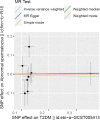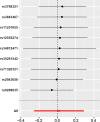Type 2 diabetes mellitus and the risk of abnormal spermatozoa: A Mendelian randomization study
- PMID: 36407300
- PMCID: PMC9666365
- DOI: 10.3389/fendo.2022.1035338
Type 2 diabetes mellitus and the risk of abnormal spermatozoa: A Mendelian randomization study
Abstract
Abnormal spermatozoa can not only reduce the fertilization rate, but also prolong the natural conception time and even increase the risk of spontaneous miscarriage. Diabetes mellitus (DM) has become a major global health problem, and its incidence continues to rise, while affecting an increasing number of men in their reproductive years. Type 2 Diabetes Mellitus (T2DM), accounting for about 85-95% of DM, is closely related to the development of sperm. However, the exact association between T2DM and abnormal spermatozoa remains unclear. Herein, we designed a Two-sample Mendelian randomization (MR) study to explore the causal association between T2DM and abnormal spermatozoa risk in European population data which come from the GWAS summary datasets. We selected 9 single nucleotide polymorphisms (SNPs) of T2DM (exposure data) as instrumental variables (IVs), and then retrieved the suitable abnormal spermatozoa genome-wide association study (GWAS) data of European from Ieu Open GWAS Project database which includes 915 cases and 209,006 control as the outcome data. Our results indicate that strict T2DM might not result in a higher risk of abnormal spermatozoa genetically in Europeans (OR: 1.017, 95% confidence interval (CI): 0.771-1.342, p=0.902). Our findings demonstrate that only T2DM may not explain the relatively higher risk of abnormal spermatozoa in men with it in Europeans. In subsequent studies, more comprehensive and larger samples need to be studied to reveal the relationship and potential mechanism between T2DM and abnormal spermatozoa.
Keywords: GWAS; Mendelian randomization; SNPs; T2DM; abnormal spermatozoa.
Copyright © 2022 Dai, Guo, Zhu, Gong, Chen, Zhong, Guo and Zhang.
Conflict of interest statement
The authors declare that the research was conducted in the absence of any commercial or financial relationships that could be construed as a potential conflict of interest. The reviewer FQ declared a shared affiliation with the authors to the handling editor at the time of review.
Figures



Similar articles
-
Causal relationship between genetically predicted type 2 diabetes mellitus and male infertility.Front Endocrinol (Lausanne). 2024 Mar 11;15:1357279. doi: 10.3389/fendo.2024.1357279. eCollection 2024. Front Endocrinol (Lausanne). 2024. PMID: 38529400 Free PMC article.
-
Investigation of the causal relationship between inflammatory bowel disease and type 2 diabetes mellitus: a Mendelian randomization study.Front Genet. 2024 Feb 16;15:1325401. doi: 10.3389/fgene.2024.1325401. eCollection 2024. Front Genet. 2024. PMID: 38435063 Free PMC article.
-
Investigating a Causal Relationship Between Diabetes Mellitus and Oropharyngeal Cancer: A Mendelian Randomization Study.Community Dent Health. 2023 Nov 30;40(4):212-220. doi: 10.1922/CDH_00025Huang09. Community Dent Health. 2023. PMID: 37988677
-
A Mendelian Randomization Study on Infant Length and Type 2 Diabetes Mellitus Risk.Curr Gene Ther. 2019;19(4):224-231. doi: 10.2174/1566523219666190925115535. Curr Gene Ther. 2019. PMID: 31553296
-
Genetically Predicted Causality of 28 Gut Microbiome Families and Type 2 Diabetes Mellitus Risk.Front Endocrinol (Lausanne). 2022 Feb 3;13:780133. doi: 10.3389/fendo.2022.780133. eCollection 2022. Front Endocrinol (Lausanne). 2022. PMID: 35185792 Free PMC article.
Cited by
-
A metabolome-wide Mendelian randomization study prioritizes causal circulating metabolites for reproductive disorders including primary ovarian insufficiency, polycystic ovary syndrome, and abnormal spermatozoa.J Ovarian Res. 2024 Aug 14;17(1):166. doi: 10.1186/s13048-024-01486-1. J Ovarian Res. 2024. PMID: 39143642 Free PMC article.
-
Causal Effects of Immune Cells on Reproductive Ill-Health, Including Abnormal Spermatozoa, Polycystic Ovary Syndrome and Spontaneous Abortion: Mendelian Randomization Analyses.J Multidiscip Healthc. 2025 Jun 6;18:3219-3232. doi: 10.2147/JMDH.S524949. eCollection 2025. J Multidiscip Healthc. 2025. PMID: 40496872 Free PMC article.
-
Sleep traits and risk of premature ovarian insufficiency - two-sample and multivariate mendelian randomisation analysis.Prz Menopauzalny. 2025 Mar;24(1):15-24. doi: 10.5114/pm.2025.150594. Epub 2025 May 12. Prz Menopauzalny. 2025. PMID: 40718014 Free PMC article.
-
Bidirectional Mendelian randomization to explore the causal relationships between the gut microbiota and male reproductive diseases.Sci Rep. 2024 Aug 7;14(1):18306. doi: 10.1038/s41598-024-69179-9. Sci Rep. 2024. PMID: 39112529 Free PMC article.
-
The Role and Mechanism of Probiotics Supplementation in Blood Glucose Regulation: A Review.Foods. 2024 Aug 27;13(17):2719. doi: 10.3390/foods13172719. Foods. 2024. PMID: 39272484 Free PMC article. Review.
References
-
- Vollset SE, Goren E, Yuan CW, Cao J, Smith AE, Hsiao T, et al. . Fertility, mortality, migration, and population scenarios for 195 countries and territories from 2017 to 2100: A forecasting analysis for the global burden of disease study. Lancet (2020) 396(10258):1285–306. doi: 10.1016/S0140-6736(20)30677-2 - DOI - PMC - PubMed
Publication types
MeSH terms
LinkOut - more resources
Full Text Sources
Medical

